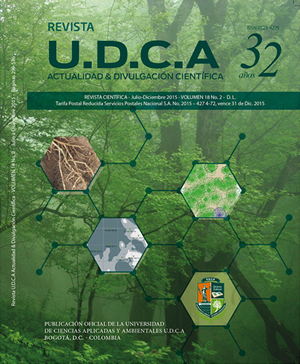Extracción y comparación de la quitina obtenida a partir del caparazon de Callinectes sapidus y Penaeus vannameis
Extraction and quantitative comparison of chitin obtained from the shellof Callinectes sapidus and Penaeus vannamei
Contenido principal del artículo
Resumen
La quitina es el polisacárido natural más abundante en la tierra después de la celulosa y se puede obtener a partir del caparazón de artrópodos. El aumento de la producción de camarón de cultivo ha dado lugar a una mayor cantidad de residuos, lo que plantea problemas ambientales, al generar enormes cantidades de caparazones, las cuales, son abandonadas como residuos. El objetivo de esta investigación fue realizar una comparación cuantitativa de la quitina presente en los caparazones de los artrópodos, utilizando técnicas de caracterización, como espectroscopia infrarroja, valoración potenciométrica y el método Kjeldahl, que hicieron posible evaluar la calidad de la quitina obtenida. Los espectros IR presentaron concordancia con las bandas de quitina del estándar y la quitina extraída del caparazón de jaiba y camarón, con respecto a las señales que aparecen a 3258cm-1 para grupos OH; a 2877cm-1 para grupos metílicos; a1654cm-1 hasta 1069cm-1 de las vibraciones de amidas I, II, y III y aminas aromáticas y de 1010cm-1 a 894cm-1, de los grupos OH y enlaces α 1,4 de este polisacárido.
Palabras clave:
Descargas
Datos de publicación
Perfil evaluadores/as N/D
Declaraciones de autoría
- Sociedad académica
- Universidad de Ciencias Aplicadas UDCA
- Editorial
- Universidad de Ciencias Aplicadas y Ambientales U.D.C.A
Detalles del artículo
Referencias (VER)
A.O.A.C. 2005. Official Methods of Analysis of the AOAC International. 18th ed. Horowitz, W.; Latimer Jr., G.W. (eds) Association of Analytical Chemists. Maryland. United States. 780p.
ABDOU, E.S.; NAGY, K.S.A.; ELSABE, M.Z. 2008. Extraction and characterization of chitin and chitosan from local sources. Bioresource Technology 99:1359-1367.
AL-SAGHEER, F.A.; AL-SUGHAYER, M.A.; MUSLIM, S; ELSABEE, M.Z. 2009. Extraction and characterization of chitin and chitosan from marine sources in the Persian Gulf. Carbohydr. Polymers. 77:410-419.
BOUGH, W.A.; SALTER, W.L.; WU, A.C.; PERKINS, B.E. 1978. Influence of manufacturing variables on the characteristics and effectiveness of chitosan products. I. Chemical composition, viscosity and molecular weight distribution of chitosan products. Biotechn. Bioeng. 20(12):1931-1943.
BRUGNEROTTO, J.; LIZARDI, J.; GOYCOOLEA, F.M.; ARGÜELLES-MONAL, W.; DESBRIÈRES, J.; RINAUD, M. 2001. An infrared investigation in relation with chitin and chitosan characterization. Polymer. 42:3569-3580.
CAHÚ, T.B.; SANTOS, S.D.; MENDES, A.; CÓRDULA, C.R.; CHAVANTE, S.F.; CARVALHO JR. L.B.; NADER, H.B.; BEZERRA, R.S. 2012. Recovery of protein, chitin, carotenoids and glycosaminoglycans from Pacific white shrimp (Litopenaeus vannamei) processing waste. Process Biochem. 47:570-577.
DOMSZY, J.; ROBERTS, G. 1985. Evaluation of infrared spectroscopic techniques for analyzing chitosan. Makromol. Chem. 186:1671-1677.
GOODRICH, J.D.; WINTER, W.T. 2007. -Chitin nanocrystals prepared from shrimp shells and their specific surface area measurement. Biomacromolec. 8:252-257.
HERNÁNDEZ, H.; ÁGUILA, E.; FLORES, O.; VIVEROS, E.L.; RAMOS, E. 2009. Obtención y caracterización de quitosano a partir de exoesqueletos de camarón. Superficies y Vacío. 22(3):57-60.
HIDALGO, C.; SUÁREZ, Y.; FERNÁNDEZ, M. 2008. Validación de una técnica potenciométrica para determinar el grado de desacetilación. Ars Pharm. 49(3):245-257.
JIANG, X.; CHEN, L.; ZHONG, W. 2003. A new linear potentiometric titration method for the determination of deacetylation degree of chitosan. Carbohydr. Polymers. 54:457-463.
KHORRAMI, K.; NAJAFPOUR, G.; YOUNESI, H.; HOSSEINPOURA, M. 2012. Production of Chitin and Chitosan from Shrimp Shell in BatchCultureof Lactobacillus plantarum. Chem. Biochem. Eng. Q. 26(3)217-223.
MASUM, S.; MONARUL, I.; MAHBUBUR, M; ASHRAFUL ISLAM MOLLA, A.; SHAIKH, S.K. 2011. Preparation of Chitosan from Shrimp Shell and Investigation of Its Properties. Int. J. Basic & Applied Sci. IJBASIJENS. 11(1):77-80.
MATHUR, N.K.; NARANG, C.K. 1990. Chitin and chitosan, versatile polysaccharides from marine animals. J. Chem. Ed. 67(11):938-942.
MEYER, S.P.; BLIGH, D. 1981. Characterization of astaxanthin pigments from heat processed crawfish waste. J. Agric. Food Chem. 29(3):505-508.
MOHAMMED, M.H.; WILLIAMS, P.A.; TVEREZOVSKAYA, O. 2013. Extraction of chitin from prawn shells and conversion to low molecular mass chitosan. Food Hydrocoll. 31:166-171.
RØDDE, R.H.; EINBU, A.; VÅRUM, K.M. 2008. A seasonal study of the chemical composition and chitin quality of shrimp shells obtained from northern shrimp (Pandalus borealis). Carbohydrate Polymers 71(3):388-393.
RUIZ, A.I.; CARDELLE-COBAS, A.; GARCÍA-BERMEJO, A.B.; MONTILLA, A.; OLANO, A.; CORZO, N. 2013. Synthesis, characterization and functional properties of galactosylated derivatives of chitosan through amide formation.Food Hydrocoll. 33:245-255.
TELI, M.D; SHEIKH, J. 2012. Extraction of chitosan from shrimp shells waste and application in antibacterial finishing of bamboo rayon. Int. J. Biol. Macromol. 50:1195-1200.







